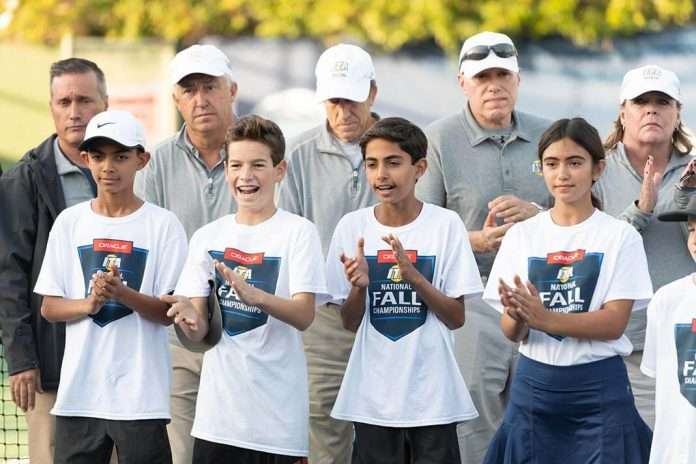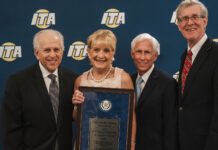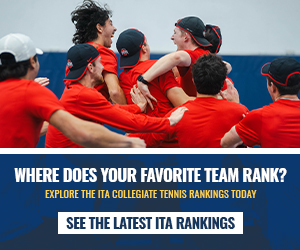By Colette Lewis
Introducing a nationwide pilot program in collegiate athletics would be daunting enough under normal circumstances, but now Intercollegiate Tennis Association’s Dave Mullins has the added challenge of implementing the Tennis For America initiative in the midst of a global pandemic.
“It’s very much like building the plane while it’s taking off,” said Mullins, the ITA’s Managing Director of Community Engagement and Coach Empowerment. “We’re learning new things all the time and then COVID-19 hits and there were a few stutters here and there. We had a few people drop out, unfortunately, and others deciding if they still want to be a part of it.”
Tennis for America is based on a Year of Service model that provides 12 months of paid, full-time community work for young Americans transitioning from college to professional careers. With funding from donors including the Chicago-based Magellan Corporation and a grant from AmeriCorps VISTA, the ITA began putting together a plan to place a dozen recent college graduates with five community tennis centers across the country: New York Junior and Tennis Learning (NYJTL) in the Bronx; the Junior Tennis Champions Center in College Park, Maryland; the XS Tennis and Education Foundation in Chicago, Illinois; the Sloane Stephens Foundation in Compton, California and the Border Youth Tennis Exchange in Tucson, Arizona.
Although six fellows have already been selected and vetted by AmeriCorps/VISTA and are prepared to begin their year of service, stay-at-home orders and the uncertainty surrounding the resumption of tennis has left others in limbo.
“We’re still in the process, because when this hit, we were going through the interviews,” Mullins said. “So there are a few that are on hold that we haven’t made offers to. Our goal initially was 12 fellows, two or three at each site, now we’re looking at eight….So we have four [candidates] for the last two spots that we’re considering and they are considering. If we have representation in each of the five cities, we have a real pilot project there and we can learn a lot from it.”
The three-day orientation and training session in Phoenix scheduled for the beginning of June has been canceled, leaving Mullins scrambling to adjust the program’s calendar, originally scheduled to begin in June and conclude next May.
“Potentially we have two fellows who may start with the Sloane Stephens Foundation in June and work remotely, so they could actually start their year of service working remotely for a month or two, and then be actually on the ground from August or September, when we get the green light again,” Mullins said. “I can see a couple starting in June, some in July, others maybe not starting until September. We may potentially lose some of the applicants because they are not able to wait around.”Dave Mullins
The uncertainty around all facets of sport, and the NCAA’s decision to grant another year of eligibility to seniors participating in spring sports, has Mullins weighing several possibilities.
“Maybe we need to start recruiting again,” Mullins said. “We could find these college seniors are not going back to play for another year now that they’ve been given that eligibility, but also recognize there’s not a lot of employment opportunities because everyone is freezing their hiring process. It’s an interesting time; it could be good for the program, it could be bad, it’s too early to tell right now.”
One of the six fellows ready to go is Gabriella Hesse, who is graduating next month from Florida Southern, a Division II school in Lakeland, Florida.
Hesse, a Communications major who is finishing her senior year from home in Colorado Springs, Colorado, is looking forward to sampling a wide variety of experiences as a fellow at the Junior Tennis Champions Center.
“I just jumped at the opportunity,” said Hesse, who knew she was interested in a career in the tennis industry after an internship at the USTA last summer. “It sounded absolutely incredible; the whole concept of a year of service that’s non-military I thought was brilliant, especially in sports.”
Hesse, who hopes to start her service in July, knows flexibility and creativity are essential for those involved in the launch of a program.
“It’s the first year, so the position descriptions aren’t super defined yet,” said Hesse, who, like all fellows, will have her housing provided and receive a monthly living stipend. “It’s nice we will be able to say, ‘hey, I’m interested in learning about this, can you tell me more?’.
“For me, it’s building on the club side, learning about what the business of that looks like, and the community outreach, what programs work, what programs don’t, how we can use that knowledge going forward,” Hesse continued. “It’s really diving in, working hard and getting my feet wet, learning what I want to do in the future in the sport of tennis.”
Read the rest on Tennis Recruiting Network.












